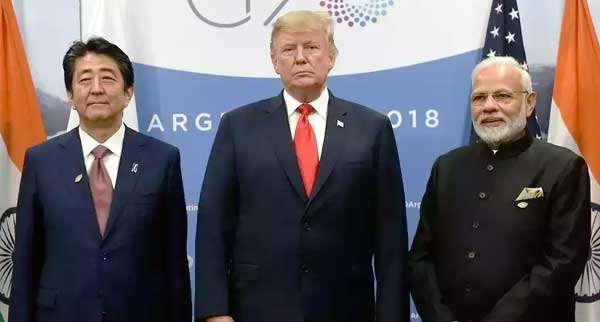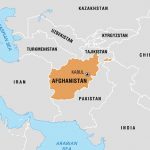
There is considerable excitement over the birth of ‘JAI’ – newest multilateral organization. As reported in the media on December 1, 2018, Prime Minister Narendra Modi while addressing the media ahead of the first ever trilateral Japan-India-America meeting on sidelines of the G-20 summit, held in Buenos Aires, Argentina, stated, “I think this is a very good occasion for our three countries, which have shared democratic values, Japan, America, India together will be playing a big role together for world peace, prosperity and stability. I am also happy that both the countries are our strategic partners, both of them are very good friends, and it is a matter of good fortune that we will work together.” Using initials of each of the three nations in Hindi to coin the term “JAI”, which combined denotes victory, PM Modi said that the acronym sends a positive message at the outset of the new partnership’s ventures to maintain peace, stability and prosperity across the world. The media lapped up the term ‘JAI’ and the ‘newly formed’ Japan-India-America partnership to promote peace and stability in the Indo-Pacific region.
But in a manner, JAI appears to be a subset or rather the core of the quadrilateral security dialogue between India, US, Japan and Australia called ‘Quad’. Recall the third round of Quad held on November 15, 2018, at Singapore on sidelines of the 13th East Asia Summit where the emphasis as earlier too was on promoting a free, open, rules-based and inclusive order in the Indo-Pacific region. Quad minus JAI only leaves out Australia, with objectives of both multilaterals remaining the same. Given the economic clout of the US and Japan, these two economic giants certainly can and are investing much more abroad compared to Australia. At the same time, Australian investments abroad by no means are too small either. At the end of 2017, the total amount of Australian money invested overseas was around $2.3 trillion (Australian currency), including $555 billion in the US and $333 billion in UK. Between 2007 and 2017, Australian investment in major Asian economies like China, Hong Kong (SAR of China), India, Japan, Republic of Korea, Taiwan and ASEAN countries also rose from $110billion to $390 billion. OK
Quad came into being because of China’s rapidly expanding military and expeditionary capabilities, and aggressive designs on the Indo-Pacific. The US proposed the Quad aimed at promoting not only free, open and rule-based order on the seas of Indo-Pacific but also envisioned Quad evolving into ministerial-level dialogue instilled with military dimensions. Nowhere was there mention of military alliance, but India remained opposed to it under the plea that ASEAN should remain central to all Indo-Pacific issues. Is the JAI partnership evolving with military dimensions acceptable to India” It does not appear to be so even as the navies of the three countries have been exercising together through the Malabar series of exercises both in the Western Pacific and the Indian Ocean, and joint US-India air and army exercises have been ongoing and with Japan are on the cards, besides bilateral dialogues and sitting together at various forums.
The trade war and increasing apprehensions about China’s Belt and Road Initiative (BRI) may be temporary setbacks to China, but the manner in which she is going about establishing ports in the Indo-Pacific beyond Gwadar and Djibouti, indicate it has no intension to give up its aggressive stance. Orchestrating review of KRA canal by the Thailand Government, developing ports of Kyaukpyu (Myanmar), Jiwani (Pakistan) and Papua New Guinea, besides granting Sri Lanka additional $295 million in 2018 after already acquiring Hambantota port for 99 years, and indebting Maldives to the tune of $1.3 billion, all point towards this. No doubt JAI and Quad both have reservations about the China’s BRI whose aim is China’s global domination. The threat to freedom of navigation and global commons is visible with China’s domineering actions in the South China Sea (SCS), including its militarization which is still continuing, disregarding international norms and the UN Convention of the Law of Seas (UNCLOS). China’s increasing focus on Southern Pacific has led US to join in an Australian naval base plan close to Papua New Guinea.
For the US, the focus at least in the short-term, may be Western Pacific and Southeast Asia, for India, the Indo-Pacific and South Asia, in addition to Southeast Asia will remain relevant. Experience shows that looking back over the years, bilateral and multilateral arrangements like the five-power defence arrangement have been largely ineffective in face of China’s militarization of the South China Sea and aggressive actions. US naval actions like freedom of navigation (FONOPS) patrols are taken by China in the stride with usual protests and rhetoric, with little deterrence to continuing Chinese actions. The bottom-line is that nations even directly affected by China’s aggressive moves have failed to show a united front. This encourages China to continue her aggressive ways, and China aims to replicate it elsewhere in the Indo-Pacific using every bit of its comprehensive national power, sugar candy being one favourite. Witness post the informal summit at Wuhan in April 2018 between Prime Minister Narendra Modi and Chinese President Xi Jinping and the recent Russia-India-China (RIC) informal summit held in Saint Petersburg, already articles are appearing in our media that India should resolve the issue of Tibet with China even before the India-China border issue is resolved.
It is good to have any amount of multilateral forums and whether JAI should be separate from Quad on account of it being more potent, or the Quad should be expanded more, is a matter of concerned governments to decide. However, the mistakes or rather the intransigence in Western Pacific should not be allowed to replicate elsewhere. Ensuring open and rule-based order on the seas of Indo-Pacific is good but there is need also to inhibit militarization of the Indian Ocean where strategic consolidation by China aims much beyond her needs to ensure safety of her sea lines of communications. Beyond the establishment of alternative to China’s BRI, there is also requirement to collectively and effectively ‘dissuade’ nations from falling into China’s debt trap policy, from which China extracts strategic victories. Such dissuasive measures may need to go beyond those in vogue presently; for example, focused collective investments. Finally, is the question to ‘act’ when the instigation comes, of which Chinese love to provide ample opportunities. How this can be done by JAI, Quad or a larger multilateral is the challenge without declaring a formal military alliance. Working out and streamlining its execution will need to be addressed.




